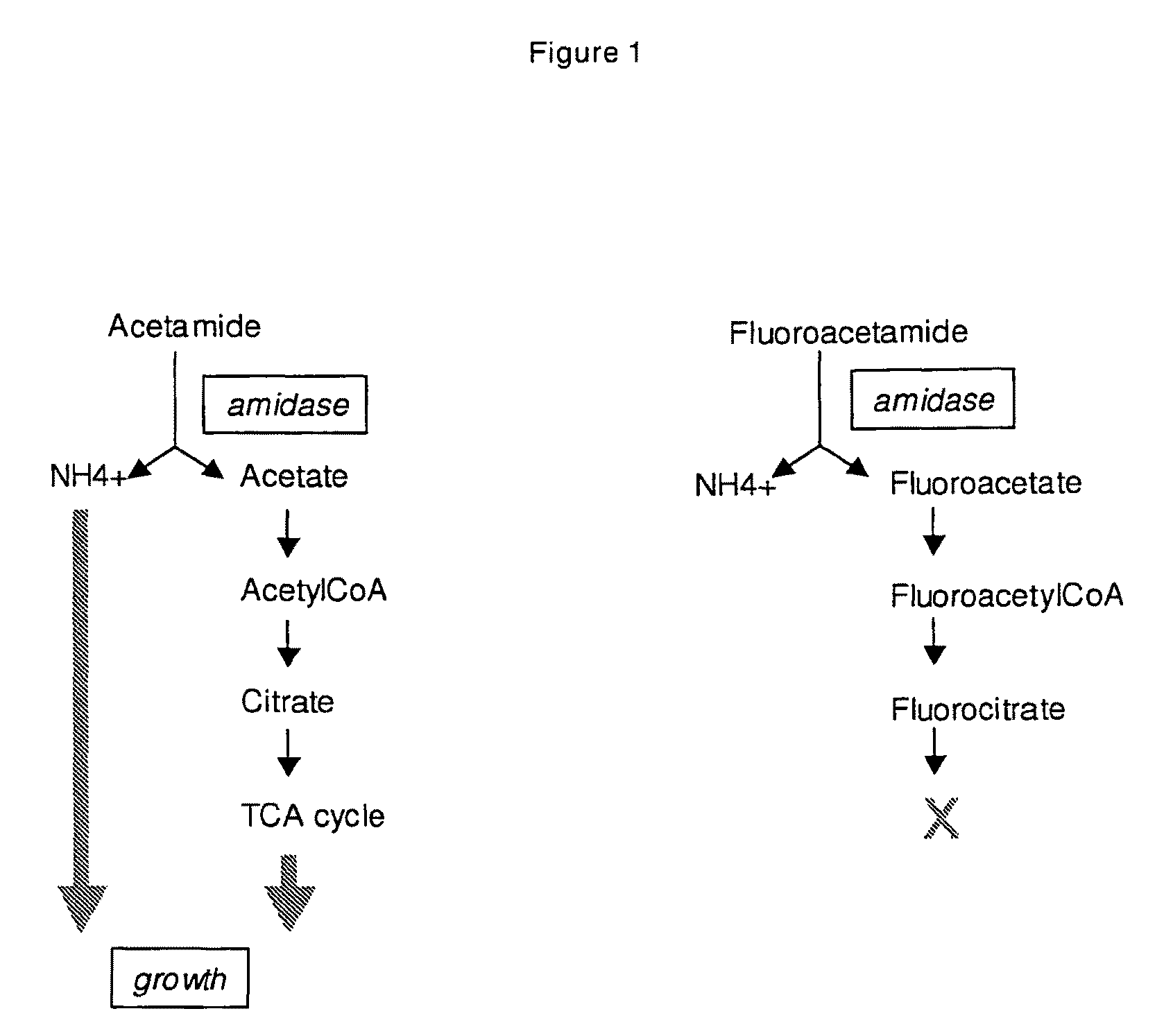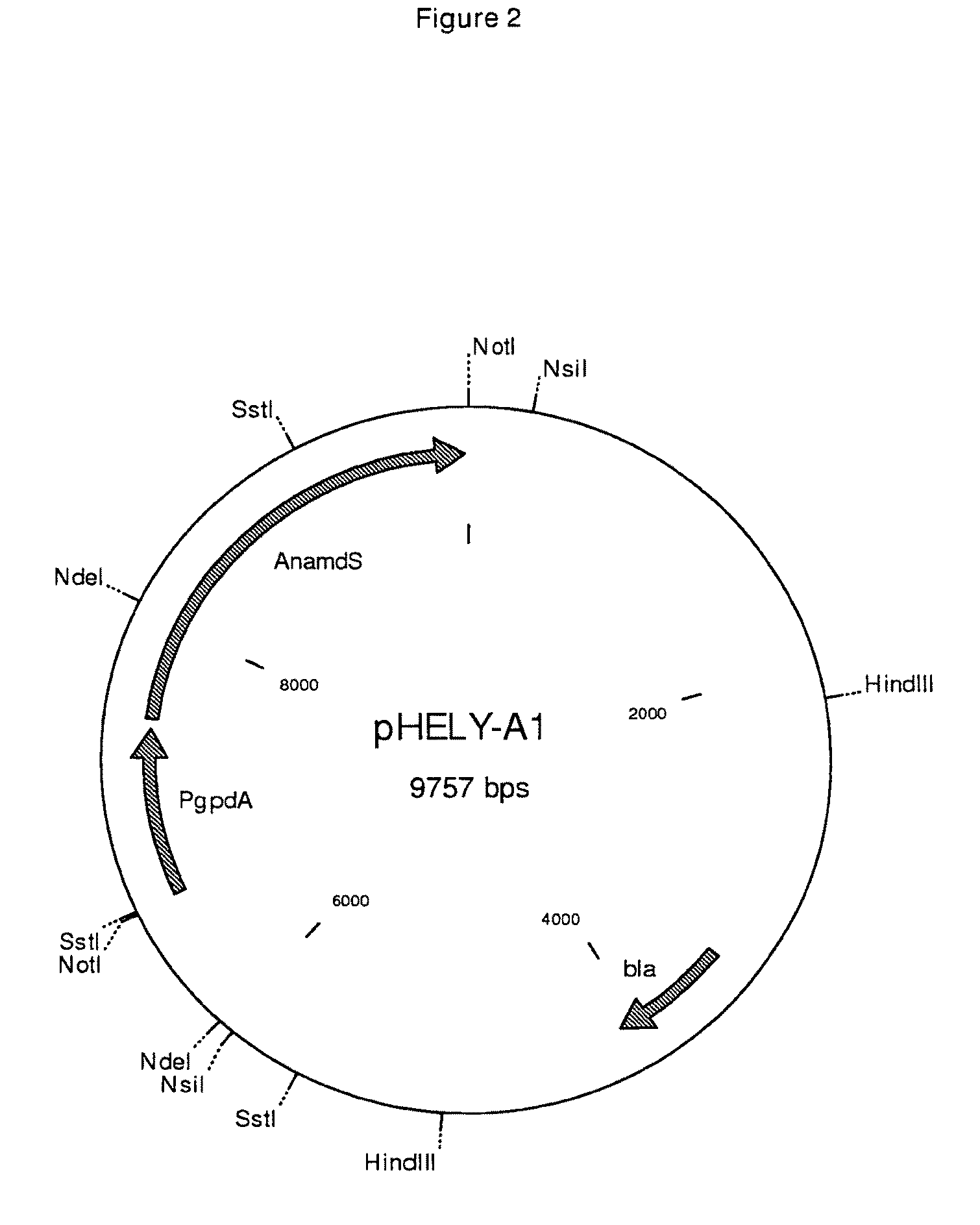Bi-directional selection markers with improved activity
a selection marker and activity technology, applied in the field of new amds genes, can solve the problems of major drawbacks of amds genes and obvious problems
- Summary
- Abstract
- Description
- Claims
- Application Information
AI Technical Summary
Benefits of technology
Problems solved by technology
Method used
Image
Examples
example 1
[0086]Wild type Penicillium chrysogenum cells do not use acetamide as sole N-source Penicillium chrysogenum strain Wisconsin 54-1255 (ATCC 28089) was tested for growth on acetamide plates, prepared as described previously (Cantwell C A, Beckmann R J, Dotzlaf J E, Fisher D L, Skatrud P L, Yeh W K, Queener S W (1990) Curr Genet. 17:213-21.) and several growth stages of cells were plated out: spores, mycelium and protoplasts. None of these gave significant growth on acetamide plates, demonstrating that wild type Penicillium chrysogenum is not able to use and grow on acetamide.
example 2
Transformation of Penicillium chrysogenum with Aspergillus nidulans amdS and Subsequent Reverse Selection
[0087]Techniques involved in the transfer of DNA to protoplasts of Penicillium chrysogenum are well known in the art and are described in many references, including Finkelstein and Ball (eds.), Biotechnology of filamentous fungi, technology and products, Butterworth-Heinemann (1992); Bennett and Lasure (eds.) More Gene Manipulations in fungi, Academic Press (1991); Turner, in: Pühler (ed), Biotechnology, 2nd completely revised edition, VHC (1992). The Ca-PEG mediated protoplast transformation is used as described in EP 635,574. pHELY-A1 (described in WO 04106347) was used as expression construct for testing the Aspergillus nidulans amdS gene. Two μg of vector was transformed to Penicillium chrysogenum. Transformants were selected on media with acetamide as the sole nitrogen source. To secure obtaining stable transformants, first round positives were colony purified on fresh aceta...
example 3
A Known Penicillium chrysogenum amdS is not a Functional Acetamidase
[0088]An alleged Penicillium chrysogenum amdS gene (WO 9706261) was PCR amplified from Penicillium chrysogenum DNA using Herculase® Hotstart DNA Polymerase (Stratagene). The oligonucleotides of SEQ ID NO 9 and 10 were used to amplify the ORF. The amplified gene was cloned in pCR®-Blunt II-TOPO® (Invitrogen) and sequence verified before further processing. After digestion with AseI en SbfI, the ORF fragment was cloned in pGATWAn (see FIG. 3) digested with NdeI en NsiI, resulting in the PcamdS expression vector pGPcamdScA (FIG. 4). Vector pGPcamdScA (2 μg) was transformed to Penicillium chrysogenum and plated out on media with acetamide as the sole carbon source. No colonies were obtained, demonstrating that the Penicillium chrysogenum amdS gene is not functional. Although WO 9706261 discloses this gene sequence with low homology to the Aspergillus nidulans amdS gene sequence to be present in the genome of Penicillium...
PUM
| Property | Measurement | Unit |
|---|---|---|
| pressure | aaaaa | aaaaa |
| resistance | aaaaa | aaaaa |
| speed | aaaaa | aaaaa |
Abstract
Description
Claims
Application Information
 Login to View More
Login to View More - R&D
- Intellectual Property
- Life Sciences
- Materials
- Tech Scout
- Unparalleled Data Quality
- Higher Quality Content
- 60% Fewer Hallucinations
Browse by: Latest US Patents, China's latest patents, Technical Efficacy Thesaurus, Application Domain, Technology Topic, Popular Technical Reports.
© 2025 PatSnap. All rights reserved.Legal|Privacy policy|Modern Slavery Act Transparency Statement|Sitemap|About US| Contact US: help@patsnap.com



